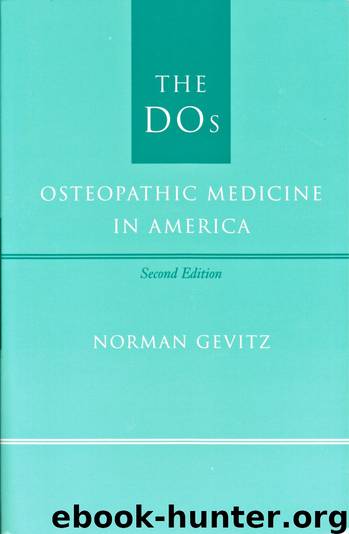The DOs: Osteopathic Medicine in America, 2nd ed. by Norman Gevitz

Author:Norman Gevitz
Language: eng
Format: epub
Publisher: JHU Press
Published: 2003-12-31T16:00:00+00:00
An Amalgamation in California
The reaction of the AOA Conference Committee members who met two days after the AMA house vote was one of bitter disappointment. Al though they were far from pleased with “the Cline Report” in its entirety, they concluded that on the whole it was reasonably fair. As far as the decision of the AMA house was concerned, it simply reinforced their belief that politics was at the heart of the cultism issue.36 At the AOA House of Delegates meeting the following month, the actions of the AMA were largely ignored in the official sessions. The association restated its position of cooperation with any group whenever such cooperation might be expected to lead to improved health care for the American people. It retained its national Conference Committee for that purpose and urged the establishment of similar committees on the local level.37
As in the case of their national association, leaders of the California Osteopathic Association were greatly upset by the AMA house vote on the Cline Report. Nevertheless, they clearly recognized that the on-site visitations had opened many of the delegates’ eyes to what was actually taught in osteopathic schools and in so doing had helped to raise DOs’ standing and status among MDs generally. What now remained to be done to facilitate a local merger was to push the AOA towards meeting the Rouse conditions, so that the stigma of the cultist label would be removed, thereby eliminating any possible AMA objections to amalgamation. At its May 1957, meeting the COA House of Delegates passed a resolution urging the deletion from all AOA printed materials of those statements referring to the osteopathic profession as a separate, independent, and complete school of medicine, and the removal of all possibly “cultist” terminology employed by the colleges and hospitals, and it directed its delegation to the AOA house to make every effort to implement these changes.38
That July, during the national convention, debate centered on the AOA constitution, which then read in part:
The objects of this Association shall be to promote the public health and the art and science of the osteopathic school of practice of the healing arts, by maintaining high standards of osteopathic education and by advancing the profession’s knowledge of surgery, obstetrics, and the prevention, diagnosis and treatment of disease in general; by stimulating original research and investigation, and by collecting and disseminating the results of such work for the education and improvement of the profession and the ultimate benefit of humanity; that the evolution of the osteopathic principles shall be ever growing tribute to Andrew Taylor Still whose original researches made possible osteopathy as a science.39
In place of this awkward, “cultist”—sounding testament, a majority of the members of a Special Reference Committee of the house proposed that this part of the constitution, known as article 2, be amended to read simply, “The objects of this Association shall be to promote the public health, to encourage scientific research and to improve high standards of medical education.” This was moved by the California delegation from the floor.
Download
This site does not store any files on its server. We only index and link to content provided by other sites. Please contact the content providers to delete copyright contents if any and email us, we'll remove relevant links or contents immediately.
Whiskies Galore by Ian Buxton(41561)
Introduction to Aircraft Design (Cambridge Aerospace Series) by John P. Fielding(32906)
Rewire Your Anxious Brain by Catherine M. Pittman(18337)
Craft Beer for the Homebrewer by Michael Agnew(17953)
Cat's cradle by Kurt Vonnegut(14804)
Sapiens: A Brief History of Humankind by Yuval Noah Harari(14006)
Leonardo da Vinci by Walter Isaacson(12833)
The Tidewater Tales by John Barth(12414)
Underground: A Human History of the Worlds Beneath Our Feet by Will Hunt(11857)
Thinking, Fast and Slow by Kahneman Daniel(11837)
The Radium Girls by Kate Moore(11652)
The Art of Thinking Clearly by Rolf Dobelli(9951)
A Journey Through Charms and Defence Against the Dark Arts (Harry Potter: A Journey Throughâ¦) by Pottermore Publishing(9147)
Mindhunter: Inside the FBI's Elite Serial Crime Unit by John E. Douglas & Mark Olshaker(8751)
Tools of Titans by Timothy Ferriss(7850)
Wonder by R. J. Palacio(7756)
Turbulence by E. J. Noyes(7733)
Change Your Questions, Change Your Life by Marilee Adams(7405)
Nudge - Improving Decisions about Health, Wealth, and Happiness by Thaler Sunstein(7273)
